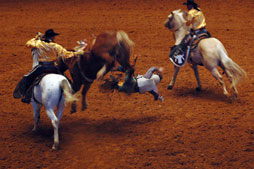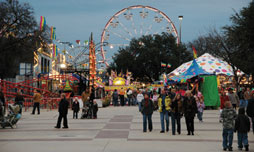By Susan Tallant/editor-in-chief
(First in a five-part series on Fort Worth’s Western heritage.)

It began without a name. It began as a quest for better meat. But on that spring day in 1896, when a few ranchers got a couple of cattle together under ice-capped shade trees, the show was born.
The Fort Worth Stock Show and Rodeo, an event that draws more than 22,000 animals from more than 40 states and several foreign countries, is now a three-week extravaganza in its 111th year.
“ Fort Worth is such a great city in the first place, and the stock show is so welcoming, it makes people want to come back,” Shanna Weaver, publicity manager of the Fort Worth Stock Show and Rodeo, said.
Weaver said everyone just loves Cowtown, and the brags can be heard over and over again in the barns.
Attendance at this year’s show is only slightly down, because of the icy cold weather at the beginning of the show, with attendance of 570,000 from opening day through Jan. 29.
“ It is unfortunate that the [cold] weather fell at the front of our show, but this is an agriculture industry and with the last few years of drought, any benefit we receive far outweighs any less [money] that the show might encounter,” she said. “The much needed rain is a good thing.”
Weaver said 85 percent of the show’s activities take place in a climate-controlled building, so the rainy days do not always affect attendance.
The show runs through Feb. 4, so there are still a few days left to enjoy the cowboys, critters, corndogs and carnival rides. And do not forget the shopping.
The Stock Show has more than four acres of shops offering something for every cowpoke. For more information about the show, check out the Web site at www.fwssr.com.
Here are a few facts about the show and how it got its start:
The beginnings

The first event was a one-day show, held in March 1896 on the banks of Marine Creek in North Fort Worth. A second two-day show followed in October of that year to coincide with the National Livestock Exchange Convention meeting.
Most exhibitors preferred the spring dates, so the show was moved back to March until 1948 when the January and February dates were adopted. The move fit better with other livestock events around the country, establishing a regular circuit for the exhibitors.
The show has returned each year except for 1943 when all facilities in Fort Worth were devoted to the World War II effort.
The names
The show has had five names. After the first year, it was called the Texas Fat Stock Show. Later, the name was changed to Fort Worth Fat Stock Show and then the National Feeders and Breeders Show.
The term “fat” was a trendy part of the name because the animals were blessed with a good supply of it, adding to the taste and providing lard to cook with.
The name Southwestern Exposition and Fat Stock Show was chosen in 1918 to broaden the scope of exhibitor involvement. The current name, Southwestern Exposition and Livestock Show, was chosen in 1988 to better reflect modern trends.
The Fort Worth Stock Show and Rodeo is the name given to the three-week event by Southwestern Exposition and Livestock Show, Inc., open year round for planning.
The parade
The first parade opened the Stock Show Oct. 12, 1896. It is held each year on the first Saturday of the show and now features more than 200 entries including marching bands, antique freight wagons and riding groups.
This year’s parade, with an expected crowd of 127,000, was cancelled because of adverse weather on Jan. 13. This was only the fourth cancellation in its 111-year history.
Phillip Schutes, parade chairman, had to make the decision early. The temperature at 7 a.m. was 31 degrees with ice in the forecast. “Safety is our first consideration,” he said. “It was just too risky.”
1 The rodeo 1
In 1917, the editor and publisher of the Daily Reporter and Sunday North Fort Worth News suggested an idea to the stock show manager that led to a competition featuring cowboys and cowgirls. A committee of livestock commission men was formed to work out the details and a discussion was held to give the contest a name.
One man suggested “rodeo” (pronouncing it ro-DAY-o, a Mexican term for such a contest). After writing the word on a blackboard, another man said it is supposed to be pronounced rode-EE-o, and so the indoor arena was born.
Fort Worth is considered leader in this sport, claiming the “World’s Original Indoor Rodeo.”
The firsts
Brahma bull riding, considered the most dangerous and exciting event of the rodeo, was introduced by late rodeo producer, Verne Elliot.
The first side release chutes for bucking horse and bull stock, also by Elliot, were introduced to the rodeo in 1927. The chutes are now an industry standard.
NBC produced the first live radio broadcast of a rodeo in 1932 through WBAP.
Gene Autry, movie star and popular singer, was the first specialty act to appear at the show, during WWII.
ABC produced the first live television coverage of a complete rodeo performance, reaching 8 million viewers. Guest stars included Roy Rogers, Dale Evans, George “Gabby” Hayes and the Sons of the Pioneers.
The numbers
The show annually draws more than 3,000 equine, more than 22,000 animals, visitors from more than 80 foreign nations, average attendance of more than 900,000 and generates an economic impact in excess of $100 million for the Fort Worth area.
























